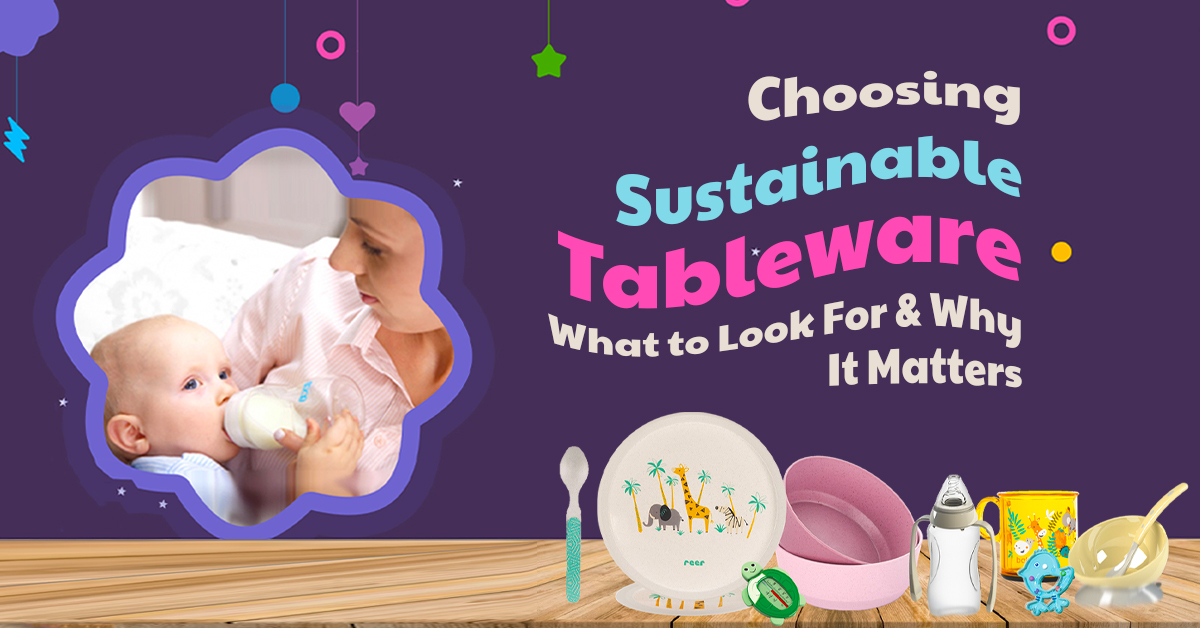

Choosing Sustainable Tableware: What to Look For and Why It Matters
In today’s world, with a heightened focus on environmental conservation, numerous new parents are actively seeking ways to reduce their carbon footprint.
This is being particularly followed for the sake of their children’s future. Eco-conscious parenting starts with mindful decisions.
It encompasses everything from the food we eat to the sustainable tableware we purchase for our infants. This blog post aims to assist you in selecting ethical tableware alternatives, sustainable baby products.
This is to ensure that your choices not only contribute positively to the environment but also prioritise the safety and well-being of your child.
Various materials are used for baby tableware, such as plastic, ceramic, stainless steel, silicone, glass, plant fibres, and porcelain-like substitutes.
Here we will examine these materials to identify which ones meet the health and environmental standards for babies.
Our goal is to provide insight into the qualities of each material, empowering parents to make informed decisions when choosing sustainable tableware for their children keeping in mind how to make it eco-friendly.
Tips for Making Eco-Friendly Choices:-
Research Brands
Seek out brands that prioritise transparency regarding their manufacturing processes and demonstrate a steadfast commitment to sustainability while creating organic table accessories.
Read Labels
When making purchases, strive to comprehend the materials and ingredients present in the products. Whenever feasible, opt for items that are natural, organic, and sourced sustainably.
Choose Well, Buy Smart
Choosing high-quality eco-friendly dinnerware that have a longer lifespan can contribute to waste reduction and lead to financial savings over time.
Recycle and Reuse
Whenever feasible, opt for products that can be recycled or reused to minimise waste.
Understanding Tableware for Babies
Entering parenthood often entails facing numerous decisions, including selecting suitable products for your baby. Certain baby items, tableware, eco-friendly dinnerware, feeding bottles, etc., may be crafted from unsustainable materials.
That might pose harm to the environment. They also will prove to be less durable and cost-effective over time. Opting for ethical tableware alternatives enables parents to lessen their environmental footprint while maintaining a natural environment for their baby.
Moreover, tableware for babies is different from that of adults. Tableware for children is specifically designed with consideration for their small hands, developing motor skills, and safety needs.
These items are typically smaller in size and more robust. Eco-friendly dinnerware are crafted from safer materials to minimise the risk of accidents and injuries.
Importance of Material Choice in Tableware for Babies
The material of tableware plays a crucial role in determining its durability, safety, and usability. Here are the most commonly used materials in kids’ tableware:
1. Silicone:
Advantages: Soft, flexible, and highly resistant to breakage. Additionally, it boasts heat resistance and is dishwasher safe.
Disadvantages: Typically pricier than plastic and may retain odours over time.
2. Stainless Steel:
Advantages: Exceptionally durable, effortless to clean, and devoid of chemicals such as BPA.
Disadvantages: Generally more costly and may be heavier for small hands to handle.
3. Bioplastic:
Advantages: Baby tableware made with bioplastic is environment friendly and biodegradable. Here baby tableware is made with sugarcane. It decreases the carbon footprint on Earth. Kasem International uses bioplastic to make eco-friendly dinnerware.
Disadvantages: It is costly to create and not easily available.
4. Bamboo and Wood:
Advantages: Environmentally friendly, biodegradable, and frequently crafted from renewable resources.
Disadvantages: Typically less durable than plastic or stainless steel, and may come with a higher price tag.
5. Ceramic and Glass:
Advantages: Chemical-free, simple to clean, and may be microwave safe.
Disadvantages: Fragile and not advisable for use with very young children.
What Influences Its Price?
The cost of children’s ethical tableware alternatives can vary widely depending on factors such as material, brand, design, and added features. Keep in mind that prices may fluctuate based on the intricacy of design, the reputation of the brand, and additional features such as compartments or suction bases.
Functions of Tableware for Babies
Go through these key functional aspects when selecting sustainable tableware
for babies:-
Safety
The foremost consideration should be safety. Ensure that the tableware is devoid of harmful chemicals and does not feature any sharp edges.
Durability
Children are prone to dropping items, making it crucial to select durable tableware to minimise the need for frequent replacements.
Easy Cleaning
Seek tableware that is dishwasher safe to streamline the cleaning process.
Design and Style
Vibrant colours and captivating designs can enhance the dining experience for children, making mealtime more enjoyable.
Size and Shape
Tableware should be proportionate to the size of little hands and mouths. Plates featuring sections can aid in portion control and organising food.
Making the Right Choice for Sustainable Tableware
When choosing organic table accessories for your child, take into account the following factors:
Age of Your Child: Younger children may require unbreakable plastic or silicone, whereas older kids can manage materials like ceramic or glass.
Your Lifestyle: Opt for lightweight and unbreakable options if you’re frequently on the move.
Environmental Concerns: Prioritise sustainability by considering bamboo or wood materials.
Health and Safety: Select BPA-free and non-toxic materials to ensure your child’s well-being.
Budget: Determine your budget and find the most suitable option within that range.
Conclusion
Choosing the appropriate organic table accessories for your children entails striking a balance between material selection, price, functionality, and safety.
Whether you prioritise the accessibility of bioplastic, the durability of stainless steel, the eco-friendliness of bamboo, or the elegance of ceramic, the essential aspect is to select what aligns best with your child’s requirements and your family’s lifestyle.
Keep in mind that the right sustainable tableware can not only enhance mealtime safety but also make it more enjoyable for your little ones.
Recent Posts
- The Future of Green Business: Embracing Sustainable Solutions in Thailand
- Choosing the Right Baby Products Manufacturer in Thailand: What Global Brands Need to Know
- Plastic Injection Molding in Thailand: Benefits, Process, and Industry Insights
- Top Qualities to Look for When Choosing Mold Makers in Thailand

 April 30, 2024
April 30, 2024